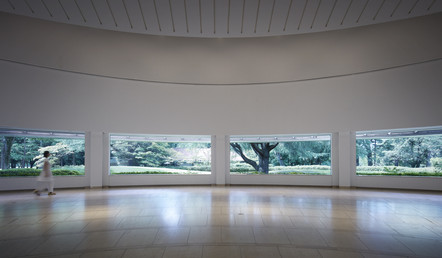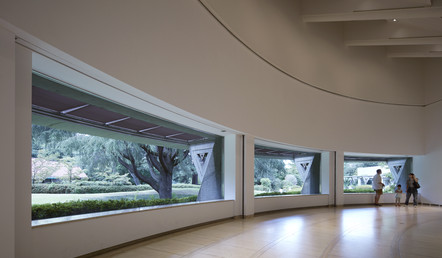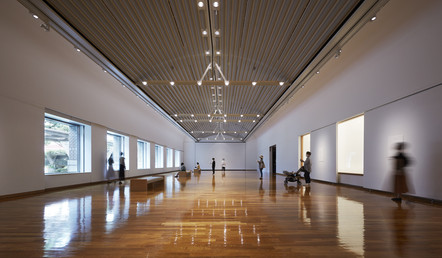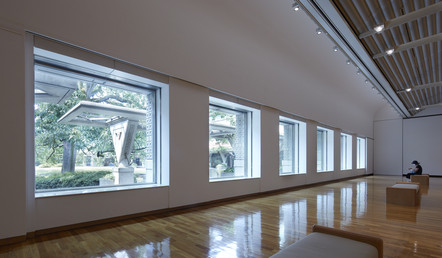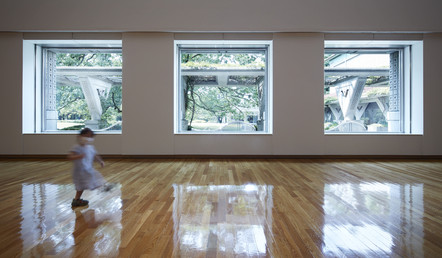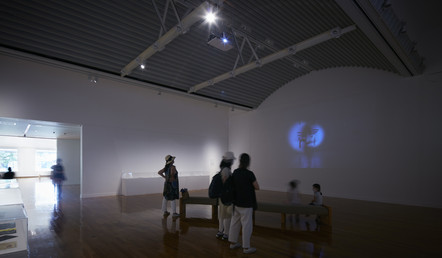We are living through a time of catastrophe, the likes of which we have never experienced.
Not one area of society is untouched by the crisis, and museums around the world are re-examining activities such as exhibitions and asking fundamental questions about what museums ought to be. Various challenges are interfering with preparations for scheduled exhibitions, including difficulties with borrowing works from overseas, and it is impossible to predict what the future may hold.
Under these circumstances, we have decided to address the public frankly and directly with a project titled “Galleries Without Artworks.”
The Setagaya Art Museum is located in Kinuta Park, a place of delightful scenery that changes with the seasons. In this park the cherry blossoms bloom in spring, large shade trees offer respite from the heat of summer, you can feast your eyes on the glorious colors of autumn foliage, and in winter it is sometimes transformed into a snowy wonderland.
Designed by architect Shozo Uchii (1933-2002), the Setagaya Art Museum opened in 1986. Uchii’s museum design was based on three key concepts: “The museum as a lived-in space,” “The museum as an open system,” and “The museum as part of a park.”
With these concepts shaping its design, the Setagaya Art Museum has a large number of windows, and it is not only the main entrance that welcomes visitors. The building is a highly open structure that seeks to merge with the surrounding environment. This museum is a facility that not only collects, stores, and exhibits art, but also places emphasis on functionally integrating diverse genres including music, theater, and other performing arts.
Since the Setagaya Art Museum first opened we have staged a wide range of programs such as music concerts and dance performances, and as part of Galleries Without Artworks, we introduce some of our activities thus far in a section titled “Architecture, Nature, and Performance.”
We hope visitors will enjoy the lush greenery of Kinuta Park through the windows and, if possible, form images in their hearts and minds of at least one of the many exhibitions they may have viewed here in the past.
Special Project: “Architecture, Nature, and Performance”
In the more than 30 years since we first opened, the museum has organized a large number of music, dance, and other performing arts events, taking advantage of our unique architectural space and the surrounding natural environment, and at times holding performances in conjunction with art exhibitions on view. We have selected approximately 40 of the nearly 400 performances that have taken place here, and are pleased to present them in the form of photographic slideshows and films documenting the events, as well as leaflets and other archival materials.
Not one area of society is untouched by the crisis, and museums around the world are re-examining activities such as exhibitions and asking fundamental questions about what museums ought to be. Various challenges are interfering with preparations for scheduled exhibitions, including difficulties with borrowing works from overseas, and it is impossible to predict what the future may hold.
Under these circumstances, we have decided to address the public frankly and directly with a project titled “Galleries Without Artworks.”
The Setagaya Art Museum is located in Kinuta Park, a place of delightful scenery that changes with the seasons. In this park the cherry blossoms bloom in spring, large shade trees offer respite from the heat of summer, you can feast your eyes on the glorious colors of autumn foliage, and in winter it is sometimes transformed into a snowy wonderland.
Designed by architect Shozo Uchii (1933-2002), the Setagaya Art Museum opened in 1986. Uchii’s museum design was based on three key concepts: “The museum as a lived-in space,” “The museum as an open system,” and “The museum as part of a park.”
With these concepts shaping its design, the Setagaya Art Museum has a large number of windows, and it is not only the main entrance that welcomes visitors. The building is a highly open structure that seeks to merge with the surrounding environment. This museum is a facility that not only collects, stores, and exhibits art, but also places emphasis on functionally integrating diverse genres including music, theater, and other performing arts.
Since the Setagaya Art Museum first opened we have staged a wide range of programs such as music concerts and dance performances, and as part of Galleries Without Artworks, we introduce some of our activities thus far in a section titled “Architecture, Nature, and Performance.”
We hope visitors will enjoy the lush greenery of Kinuta Park through the windows and, if possible, form images in their hearts and minds of at least one of the many exhibitions they may have viewed here in the past.
Special Project: “Architecture, Nature, and Performance”
In the more than 30 years since we first opened, the museum has organized a large number of music, dance, and other performing arts events, taking advantage of our unique architectural space and the surrounding natural environment, and at times holding performances in conjunction with art exhibitions on view. We have selected approximately 40 of the nearly 400 performances that have taken place here, and are pleased to present them in the form of photographic slideshows and films documenting the events, as well as leaflets and other archival materials.
